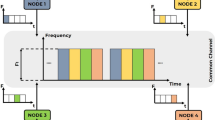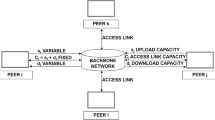Abstract
Internet protocol television (IPTV), which is quickly growing in popularity, can provide hundreds of channels; however, finding a desired IPTV channel among hundreds of channels is a difficult and time consuming issue. Since the very big number of channels, and the delay in switching between them due to network bandwidth limitations, can make it difficult for viewers to find the content they want. To solve this problem, we propose a novel method to reduce channel surfing period that is called Pre-Buffering join with Program Driven (PBPD) method. It is noted that the number of channel switches has a main effect on the channel surfing period. Our proposed method is based on programs; it means that instead of choosing channels, users select their desired programs by which they can reach the channels playing the programs. In addition we send all channels playing the selected program type plus one channel (most popular) from each group of channels playing other types of program in time slots to the STB(set-top box) including minimum one I-frame and finally we use popularity to select the channel in the STB. Simulation results show that the proposed method can reduce the number of channel switches, waiting time for the delivery of the earliest key-frame after selecting a channel and average time to join a broadcasting group; therefore, the proposed method has a good performance in comparison to other methods.






Similar content being viewed by others
References
Azgin A, Altunbasak Y (2013) Dynamic channel reordering to reduce latency during surfing periods in IPTV networks. IEEE Trans Broadcast 59(3):471–483
Bejerano Y, Koppol P (2009) Improving zap response time for IPTV. In: Proc IEEE INFOCOM, Apr, pp 1971–1979
Boyce JM, Tourapis AM (2005) Fast efficient channel change [set-topbox applications]. In: Proc IEEE Int Conf Consumer Electron Jan pp 1–2
Caenegem TV, Deschanel M (2010) Change the channel (fast please)!, DVB Scene, no 34, p 7
Cho C, Han I, Jun Y, Lee H (2004) Improvement of channel zapping time in IPTV services using the adjacent groups join-leave method. In: Proc IEEE Int Conf Adv Commun Technol vol 2. Feb pp 971–975
Degrande N, Laevens K, Vleeschauwer DD, Sharpe R (2008) Increasing the user perceived quality for IPTV services. IEEE Commun Mag 46(2):94–100
Hei X, Liang C, Liang J, Liu Y, Ross KW (2007) A measurement study of a large-scale P2P IPTV system. IEEE Trans Multimedia 9(8):1672–1687
Jennehag U, Zhang T, Pettersson S (2007) Improving transmission efficiency in H.264 based IPTV systems. IEEE Trans Broadcast 53(1):69–77
Joo H, Song H, Lee D, Lee I (2008) An effective IPTV channel control algorithm considering channel zapping time and network utilization. IEEE Trans Broadcast 54(2):208–216
Lee Y, Lee J, Kim I, Shin H (2008) Reducing IPTV channel switching time using H.264 scalable video coding. IEEE Trans Consum Electron 54(2):912–919
Lee E, Whang J, Oh U, Koh K, Bahn H (2009) A popular channel concentration scheme for efficient channel navigation in IPTV. IEEE Trans Consum Electron 55(4):1945–1949
Lee E, Ku JY, Bahn H (2014) An efficient hot channel identification scheme for IPTV channel navigation. IEEE Trans Consum Electron 60(1):124–129
Li Y, Zhang Y, Yuan R (2011) Measurement and analysis of a large scale commercial mobile internet TV system, in Proc. ACM SIGCOMM Conf Internet Meas Conf, Berlin, Germany, Nov pp 209–224
Manjunath L, Mastani SA (2013) A novel approach for increasing channel navigation in IPTV based on user’s channel selection interests. Int J Eng Res Appl (IJERA) 3(3):1331–1336
Yang C, Yong L (2015) On achieving short channel switching delay and playback lagin IP-based TV systems. IEEE Trans Multimedia 17(7):1096–1106
Zare S, Ghaffarpour Rahbar A (2012) An FEC scheme combined with weighted scheduling to reduce multicast packet loss in IPTV over PON. J Netw Comput Appl 35(1):459–468
Zare S, Ghaffarpour Rahbar A (2014) Congestion control in IPTVover PON using digital fountain forward error correction. J Netw Comput Appl 37(1):240–252
Zare S, Ghaffarpour Rahbar A (2016) Program-driven approach to reduce latency during surfing periods in IPTV networks. Multimed Tools Appl 75(23):16059–16071
Acknowledgements
This research was financially supported by Payame Noor University (PNU), Iran.
Author information
Authors and Affiliations
Corresponding author
Rights and permissions
About this article
Cite this article
Zare, S. A program-driven approach joint with pre-buffering and popularity to reduce latency during channel surfing periods in IPTV networks. Multimed Tools Appl 77, 32093–32105 (2018). https://doi.org/10.1007/s11042-018-6235-7
Received:
Revised:
Accepted:
Published:
Issue Date:
DOI: https://doi.org/10.1007/s11042-018-6235-7




